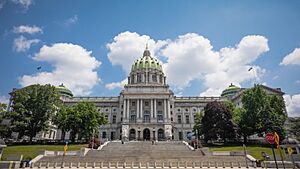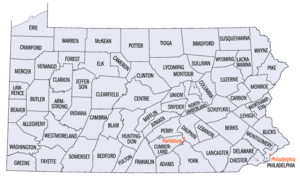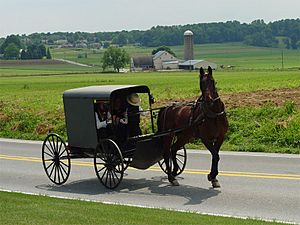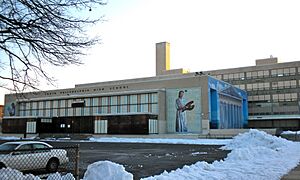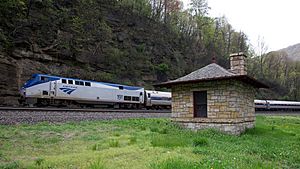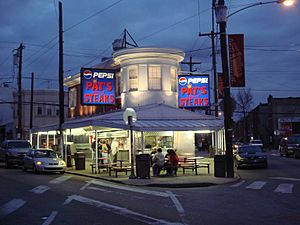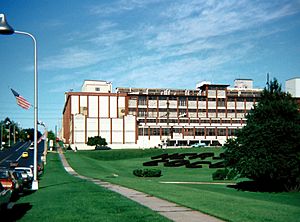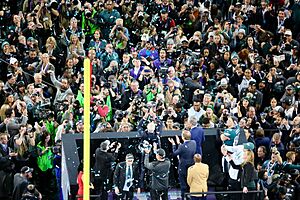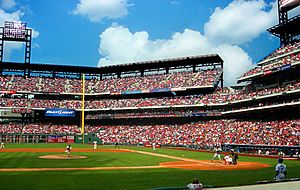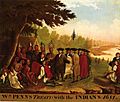Pennsylvania facts for kids
Quick facts for kids
Pennsylvania
Pennsilfaani (Pennsylvania Dutch)
|
|||
|---|---|---|---|
| Commonwealth of Pennsylvania | |||
|
|||
| Nickname(s):
The Keystone State
|
|||
| Motto(s):
Virtue, Liberty and Independence
|
|||
| Anthem: "Pennsylvania" | |||
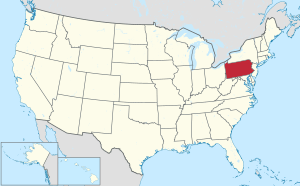
Location of Pennsylvania within the United States
|
|||
| Country | United States | ||
| Before statehood | Province of Pennsylvania | ||
| Admitted to the Union | December 12, 1787 (2nd) | ||
| Capital | Harrisburg | ||
| Largest city | Philadelphia | ||
| Largest county or equivalent | Philadelphia | ||
| Largest metro and urban areas | Delaware Valley | ||
| Legislature | General Assembly | ||
| • Upper house | State Senate | ||
| • Lower house | House of Representatives | ||
| Judiciary | Supreme Court of Pennsylvania | ||
| U.S. senators | John Fetterman (D) Dave McCormick (R) |
||
| U.S. House delegation | 10 Republicans 7 Democrats (list) |
||
| Area | |||
| • Total | 46,055 sq mi (119,283 km2) | ||
| • Land | 44,816.61 sq mi (116,074 km2) | ||
| • Water | 1,239 sq mi (3,208 km2) 2.7% | ||
| Area rank | 33rd | ||
| Dimensions | |||
| • Length | 170 mi (273 km) | ||
| • Width | 283 mi (455 km) | ||
| Elevation | 1,100 ft (340 m) | ||
| Highest elevation | 3,213 ft (979 m) | ||
| Lowest elevation
(Delaware River at Delaware border)
|
0 ft (0 m) | ||
| Population
(2024)
|
|||
| • Total | |||
| • Rank | 5th | ||
| • Density | 291.8/sq mi (112.7/km2) | ||
| • Density rank | 9th | ||
| • Median household income | $73,800 (2023) | ||
| • Income rank | 21st | ||
| Demonym(s) | Pennsylvanian Pennamite Pennsylvanier (Pennsylvania Dutch) |
||
| Language | |||
| • Official language | None | ||
| • Spoken language | |||
| Time zone | UTC– 05:00 (Eastern) | ||
| • Summer (DST) | UTC– 04:00 (EDT) | ||
| USPS abbreviation |
PA
|
||
| ISO 3166 code | US-PA | ||
| Traditional abbreviation | Pa., Penn., Penna. | ||
| Latitude | 39°43′ to 42°16′ N | ||
| Longitude | 74°41′ to 80°31′ W | ||
| Dance | None |
|---|---|
| Bird | Ruffed grouse |
| Fish | Brook trout |
| Flower | Mountain laurel |
| Tree | Eastern hemlock |
| Insect | Firefly (Colloquially "Lightning Bug") (Photuris pensylvanica) |
Pennsylvania is a state in the United States. Its name means "Penn's forest country." It is located in the Mid-Atlantic, Northeastern, Appalachian, and Great Lakes regions. Pennsylvania shares borders with Delaware, Maryland, West Virginia, Ohio, Lake Erie, New York, New Jersey, and even Canada (across Lake Erie).
The state was founded in 1681 by William Penn. He received a large land grant from the King of England. Pennsylvania was known for welcoming people of different beliefs and for its fair government. It also had peaceful relationships with Native American tribes.
Pennsylvania played a huge role in the American Revolution. Important meetings like the First Continental Congress and Second Continental Congress happened in Philadelphia. The Declaration of Independence was signed there in 1776. Pennsylvania was the second state to approve the U.S. Constitution on December 12, 1787.
During the American Civil War, the Battle of Gettysburg took place here in 1863. It was a very important and bloody battle that helped the Union win the war. Later, Pennsylvania's factories and industries helped build much of the nation's early infrastructure. This included bridges, tall buildings, and military equipment.
Pennsylvania has diverse geography. The Appalachian Mountains run through the middle of the state. About 60% of Pennsylvania is covered in forests. Even though it has no ocean coast, it has a long waterfront along Lake Erie and the Delaware River.
Pennsylvania is the fifth-most populated state in the U.S., with over 13 million people. It is the 33rd largest state by area. The biggest city is Philadelphia, which is also the sixth-largest city in the country. The second-largest city is Pittsburgh.
Contents
Pennsylvania's Story
Long before Europeans arrived, the land that is now Pennsylvania was home to many Native American groups. These included the Delaware, Susquehannock, Iroquois, and Shawnee nations.
Early Days: The 1600s
Both the Dutch and the English claimed the land around the Delaware River. The Dutch were the first to settle there in 1631. Later, in 1638, Sweden started the New Sweden Colony in the area.
In 1664, King Charles II of England gave a large land grant to James, Duke of York. This grant included parts of what the Dutch claimed. The English then took control of the Dutch lands.
On February 28, 1681, King Charles II gave a land charter to William Penn. This was to repay a debt owed to Penn's father. It was one of the biggest land gifts ever given to one person. The King named it Pennsylvania, meaning "Penn's Woods." William Penn wanted to call it "Sylvania" (forests), but the King insisted on Pennsylvania.
Penn set up a government with two new ideas. These were the county commission and freedom of religious belief. These ideas were copied in many other places in the New World. William Penn signed a peace treaty with Tammany, a leader of the Delaware tribe. This started a long period of friendship between the Quakers and the Native Americans.
Becoming a Nation: The 1700s
From 1730 to 1764, the Pennsylvania Colony printed its own paper money. This helped with the shortage of gold and silver coins. This paper money was called Colonial Scrip. Benjamin Franklin helped create this currency.
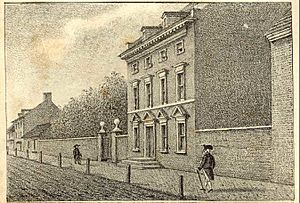
In 1774, leaders from 12 colonies met in Philadelphia for the First Continental Congress. The Second Continental Congress also met in Philadelphia in May 1775. They created and signed the Declaration of Independence there. When the British captured Philadelphia, the Congress moved to Lancaster and then to York. There, they wrote the Articles of Confederation, which formed the 13 colonies into a new nation.
Later, the U.S. Constitution was written in Philadelphia. It was drafted and signed at the Pennsylvania State House, now called Independence Hall. This is the same building where the Declaration of Independence was signed.
Pennsylvania became the second state to approve the U.S. Constitution on December 12, 1787. This was just five days after Delaware became the first.
The state government moved to Lancaster in 1799. Then, in 1812, it moved to Harrisburg, which is the capital today.
Growth and Change: The 1800s
The state government met in the old Dauphin County Court House until 1821. Then, the "Hills Capitol" building was built. This building burned down in 1897.
A new capitol building was designed by Joseph Miller Huston. It was finished and dedicated in 1907. President Theodore Roosevelt called it "the most beautiful state Capital in the nation."
James Buchanan, born in Pennsylvania, was the only U.S. President who was never married.
The Battle of Gettysburg was a major turning point of the Civil War. It happened near Gettysburg. About 350,000 Pennsylvanians served in the Union Army during the war.
Pennsylvania was also home to the first commercially drilled oil well. In 1859, near Titusville, Pennsylvania, Edwin Drake successfully drilled for oil. This started the first big oil boom in U.S. history.
Modern Times: The 1900s
At the start of the 20th century, Pennsylvania's economy focused on making steel, logging, coal mining, and textiles. Many immigrants came to the U.S. during this time. They provided a steady supply of workers for these industries.
Where is Pennsylvania?
Pennsylvania is about 170 miles (273 km) from north to south. It is 283 miles (455 km) from east to west. The state covers a total of 46,055 square miles (119,283 km2). About 44,817 square miles (116,074 km2) are land.
Pennsylvania has 51 miles (82 km) of coastline along Lake Erie. It also has 57 miles (92 km) of shoreline along the Delaware Estuary.
Major cities include Philadelphia, Reading, and Lancaster in the southeast. Pittsburgh is in the southwest. The cities of Allentown, Bethlehem, and Easton are in the central east. Scranton and Wilkes-Barre are in the northeast. Erie is in the northwest.
The state has five main geographic regions. These are the Allegheny Plateau, Ridge and Valley, Atlantic Coastal Plain, Piedmont, and the Erie Plain.
Neighboring States
- New York (North)
- Ontario, Canada (Northwest, across Lake Erie)
- Maryland (South)
- Delaware (Southeast)
- West Virginia (Southwest)
- New Jersey (East)
- Ohio (West)
How Pennsylvania is Governed
Pennsylvania has had five different constitutions since it became a state. The current one was adopted in 1968. Before statehood, it had four "Frames of Government" starting in 1682. The capital city is Harrisburg. The state legislature meets there in the State Capitol.
The Governor and Executive Team
The executive branch of Pennsylvania's government includes the Governor, Lieutenant Governor, Attorney General, Auditor General, and Treasurer. The Governor and Lieutenant Governor are elected together every four years.
Making Laws: The Legislature
Pennsylvania has a two-part legislature called the General Assembly. It was created in 1790. It has 50 senators and 203 representatives.
Courts and Justice
Pennsylvania is divided into 60 judicial districts. Most minor cases and preliminary hearings are handled by district justices. More serious criminal and civil cases start in the Courts of Common Pleas. The Superior Court handles most appeals. All judges in Pennsylvania are elected by the people.
Local Towns and Counties
Pennsylvania has 67 counties. These counties are divided into cities, boroughs, or townships. Philadelphia County is the most populated county. Cameron County is the least populated.
There are 56 cities in Pennsylvania. Philadelphia is the only "first-class" city because it is so large. Pittsburgh and Scranton are "second-class" cities. All other cities are "third-class."
Boroughs are usually smaller than cities. There are 958 boroughs in Pennsylvania. The largest is State College.
Townships are another type of municipality. There are two kinds: first-class and second-class. A second-class township can become a first-class township if it grows big enough.
Bloomsburg is special because it is the only official "town" in the state.
Who Lives in Pennsylvania?
As of the 2020 U.S. census, Pennsylvania had a population of over 13 million people. This makes it the fifth-most populated state in the U.S.
Where People Come From
Most people living in Pennsylvania (74.5%) were born in the state. About 18.4% were born in another U.S. state. A smaller number (5.6%) were born in other countries. People born outside the U.S. mostly come from Asia, Europe, and Latin America.
The largest ancestry groups in Pennsylvania include:
- German (28.5%)
- Irish (18.2%)
- Italian (12.8%)
- African American (9.6%)
- English (8.5%)
- Polish (7.2%)
- French (4.2%)
Diverse Communities
| Race and ethnicity | Alone | Total | ||
|---|---|---|---|---|
| White (non-Hispanic) | 73.4% |
|
76.6% |
|
| African American (non-Hispanic) | 10.5% |
|
11.8% |
|
| Hispanic or Latino | — | 8.1% |
|
|
| Asian | 3.9% |
|
4.5% |
|
| Native American | 0.1% |
|
1.1% |
|
| Pacific Islander | 0.02% |
|
0.1% |
|
| Other | 0.4% |
|
1.3% |
|
The number of Hispanic or Latino Americans in Pennsylvania grew a lot between 2000 and 2010. Many came from Puerto Rico, the Dominican Republic, and Mexico. The Asian population also grew quickly, with many people from India, Vietnam, and China.
Most Hispanic or Latino Americans in Pennsylvania are of Puerto Rican descent. They are mainly found in Philadelphia, the Lehigh Valley, and South Central Pennsylvania.
Most Black residents in the state are African American. They are descendants of African slaves brought to the U.S. south. There are also growing numbers of Black people from the West Indies and Africa. Most Black residents live in the Philadelphia area, Pittsburgh, and South Central Pennsylvania.
Non-Hispanic white people make up the majority of Pennsylvania's population. They are mostly from German, Irish, Scottish, Welsh, Italian, and English backgrounds. Rural parts of South Central Pennsylvania are known for their Amish communities.
Age Groups and Support
As of 2010, Pennsylvania had one of the highest percentages of older citizens (65+) in the nation, at 15.4%. The state's poverty rate was 12.5% in 2017.
Languages Spoken Here
| Language | Percentage of population (as of 2010) |
|---|---|
| Spanish | 4.1% |
| German (including Pennsylvania Dutch) | 0.9% |
| Chinese (including Mandarin) | 0.5% |
| Italian | 0.4% |
| French | 0.3% |
| Russian | 0.3% |
| Vietnamese | 0.3% |
| Korean | 0.3% |
| Polish | 0.2% |
| Arabic | 0.2% |
| Hindi | 0.2% |
In 2010, about 90.2% of Pennsylvania residents aged 5 and older spoke English at home. Spanish was spoken by 4.1% of the population. German (including Pennsylvania Dutch) was spoken by 0.9%.
Pennsylvania Dutch Language Explained
Pennsylvania German is often called "Pennsylvania Dutch." The word "Dutch" used to mean "German." The Pennsylvania German language comes from a German dialect. It is still spoken by Old Order Amish and Old Order Mennonite people, especially in Lancaster County.
Religious Diversity
| Religion in Pennsylvania (2014) | ||||
|---|---|---|---|---|
| religion | percent | |||
| Protestant | 47% | |||
| Catholic | 24% | |||
| Unaffiliated | 21% | |||
| Other faiths/don't know | 2% | |||
| Hindu | 1% | |||
| Jehovah's witnesses | 1% | |||
| Jewish | 0.8% | |||
| Muslim | 0.6% | |||
Pennsylvania was one of the few colonies that offered true religious freedom. William Penn believed in treating everyone kindly, no matter their beliefs. This led to a wide variety of religions in the state, which continues today.
In 2010, about 53.8% of Pennsylvania's population belonged to an organized religion. The largest religious group is the Roman Catholic Church. Other large groups include the United Methodist Church and the Evangelical Lutheran Church in America.
Pennsylvania has one of the largest communities of Presbyterians in the nation. The Presbyterian Church (USA) is the largest Presbyterian group here. The state also has a very large Amish population, second only to Ohio.
Pennsylvania's Economy: How it Works
As of 2023, Pennsylvania's economy is the sixth-largest among all U.S. states. If Pennsylvania were its own country, its economy would be the 20th-largest in the world. In 2016, over 5.3 million people worked in Pennsylvania. As of January 2024, the state's unemployment rate was 3.4%.
Pennsylvania has five main manufacturing areas. These are Philadelphia, Pittsburgh, Erie, Scranton-Wilkes-Barre, and the Lehigh Valley.
Pennsylvania is home to 23 of the nation's 500 largest companies. These include Cencora and Comcast. Philadelphia is a leader in finance and insurance. Pittsburgh is home to companies like U.S. Steel and Heinz. The Hershey Company in Hershey is one of the world's biggest chocolate makers.
Walmart is the largest private employer in Pennsylvania. The University of Pennsylvania is the second-largest employer.
Pennsylvania leads the nation in several areas. These include beer production, farmers' markets, food processing companies, hardwood lumber, mushroom farms, natural gas production, and pretzel manufacturing.
Farming and Food Production
Pennsylvania ranks 19th among all states in farming. Its top farm products include mushrooms, apples, Christmas trees, eggs, milk, and grapes. Pennsylvania is also eighth in the nation for winemaking.
The "PA Preferred" program helps to brand farm products grown or made in the state. Farming in Pennsylvania supports over 66,800 jobs in the food manufacturing industry.
Banks and Money
The first nationally chartered bank in the U.S., the Bank of North America, was founded in 1781 in Philadelphia. Today, it is part of Wells Fargo. PNC, based in Pittsburgh, is currently the state's largest bank.
Movies Made Here
The Pennsylvania Film Production Tax Credit started in 2004. This helped grow the film industry in the state.
Casinos and Gaming
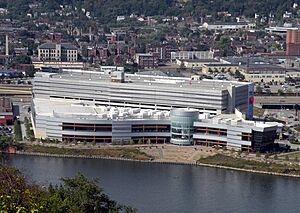
Casino gaming became legal in Pennsylvania in 2004. As of 2022, there are 16 casinos in the state.
Learning in Pennsylvania
Pennsylvania has 500 public school districts and many private schools. It also has publicly funded colleges and universities, and over 100 private higher education institutions.
Schools for Kids and Teens
In Pennsylvania, children must attend school between ages eight and 17. They can also graduate from high school earlier. In 2005, 83.8% of young adults aged 18 to 24 had graduated from high school.
Pennsylvania students generally do well on standardized tests. In 2007, the state ranked high in math, reading, and writing for eighth graders. Parents can also choose to homeschool their children.
Colleges and Universities
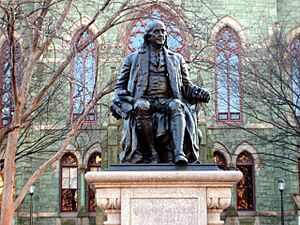
The Pennsylvania State System of Higher Education (PASSHE) includes 14 state-owned universities. West Chester University is the largest of these. The Commonwealth System of Higher Education includes four state-related schools: Pennsylvania State University, Lincoln University, the University of Pittsburgh, and Temple University.
Carnegie Mellon University, Pennsylvania State University, the University of Pennsylvania, and the University of Pittsburgh are all top research universities. Lehigh University is another private research university.
The University of Pennsylvania, founded in Philadelphia in 1740 by Benjamin Franklin, is Pennsylvania's only Ivy League university. It is considered the first university in the United States. The Lake Erie College of Osteopathic Medicine (LECOM) is the largest medical school in the U.S. The Pennsylvania Academy of the Fine Arts is the first and oldest art school in the country.
Fun Things to Do
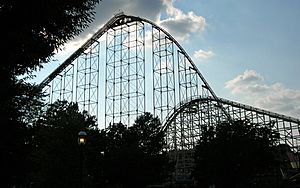
Pennsylvania is home to the nation's first zoo, the Philadelphia Zoo. Other zoos include the Erie Zoo and the Pittsburgh Zoo & PPG Aquarium.
The state has many notable museums. These include the Allentown Art Museum, Carnegie Museums in Pittsburgh, and the Philadelphia Museum of Art. The Houdini Museum in Scranton is the only museum in the world dedicated to the famous magician.
All 121 state parks in Pennsylvania offer free admission.
Pennsylvania has many fun amusement parks. Some popular ones are Dorney Park & Wildwater Kingdom, Dutch Wonderland, Hersheypark, and Kennywood. The largest indoor waterpark on the U.S. East Coast is Splash Lagoon in Erie.
Famous music festivals include Musikfest in Bethlehem, which is the nation's largest free music festival. The Great Allentown Fair is one of the longest-running annual fairs.
Nearly one million people have hunting licenses in Pennsylvania. Common animals to hunt include white-tail deer, black bear, and turkey. Hunting brings a lot of money to the state's economy.
Getting Around Pennsylvania
The Pennsylvania Department of Transportation (PennDOT) manages transportation in the state.
Airports
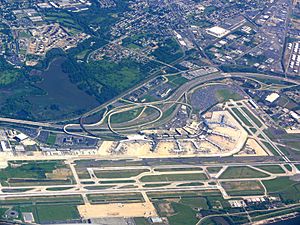
Pennsylvania has seven major airports. These include Philadelphia International, Pittsburgh International, and Harrisburg International. There are 134 public-use airports in the state.
Buses and Coaches
Bus services connect cities in Pennsylvania and other parts of the Northeast. Companies like Greyhound Lines and Megabus provide these services.
Roads and Highways
PennDOT owns over 39,861 miles (64,152 km) of roads. This makes it the fifth-largest state highway system in the U.S. The Pennsylvania Turnpike system is 535 miles (861 km) long. It stretches from Ohio to Philadelphia and New Jersey.
Other major highways include Interstate 80 and Interstate 90. North-south highways include Interstate 79 and Interstate 81.
Trains
SEPTA operates trains and buses in the Philadelphia area. Pittsburgh Regional Transit provides bus and light rail service in Pittsburgh.
Amtrak provides intercity passenger train service. The Keystone Service runs between Harrisburg and Philadelphia. The Northeast Regional provides service along the Northeast Corridor. Philadelphia's 30th Street Station is Amtrak's third-busiest train station in the nation.
Pennsylvania has the most short-line freight railroads of any U.S. state, with 67.
Waterways
The Port of Pittsburgh is the second-largest inland port in the U.S. The Port of Philadelphia is also a major port. Pennsylvania's only port on the Great Lakes is in Erie.
Pennsylvania's Culture
Delicious Foods
Pennsylvania is known as the snack food capital of the world. It makes more pretzels and potato chips than any other state. Sturgis Pretzel House introduced pretzels to American consumers in 1861. Companies like Utz Brands and Wise Foods make many of the nation's potato chips.
The Hershey Company in Hershey is one of the world's leading chocolate makers. Other candy companies include Just Born (makers of Peeps) and Boyer Brothers (Mallo Cups). The pretzel company Auntie Anne's started in Pennsylvania.
Traditional Pennsylvania Dutch foods include chicken potpie, ham potpie, and Shoofly pie. D.G. Yuengling & Son, America's oldest brewery, has been making beer in Pottsville since 1829.
In Philadelphia, famous foods include cheesesteaks, hoagies, and soft pretzels. In Pittsburgh, Henry John Heinz improved tomato ketchup. Pittsburgh is also known for Primanti Brothers Restaurant sandwiches and pierogies.
Sports in Pennsylvania
Professional Sports Teams

Pennsylvania is home to eight major professional sports teams:
- Baseball: Philadelphia Phillies and Pittsburgh Pirates (Major League Baseball)
- Basketball: Philadelphia 76ers (NBA)
- Football: Philadelphia Eagles and Pittsburgh Steelers (NFL)
- Hockey: Philadelphia Flyers and Pittsburgh Penguins (NHL)
- Soccer: Philadelphia Union (Major League Soccer)
These teams have won many championships. Philadelphia is often called the "nation's best sports city" because of its many teams and passionate fans.
Pennsylvania also has many minor league baseball and hockey teams. The Little League World Series has been held annually in South Williamsport since 1959.
Motorsports
The famous Mario Andretti family of race car drivers is from Nazareth. Pennsylvania has several racetracks, including Pocono Raceway, which hosts NASCAR Cup Series races. Maple Grove Raceway hosts major drag racing events.
Horse racing tracks in Pennsylvania include The Meadows and Parx Racing.
College Sports
In college football, three Pennsylvania universities play at the highest level: Penn State, Pitt, and Temple. Penn State plays its home games at Beaver Stadium, one of the largest stadiums in the nation.
In college basketball, five Philadelphia-area universities are known as the "Big Five." They have a rich history in NCAA Division I basketball.
Pennsylvania also has several universities known for college wrestling. Penn State has won many national wrestling championships.
Nicknames
Since 1802, Pennsylvania has been known as the Keystone State. This is its most popular nickname. A "keystone" is the central stone that holds an arch together. This nickname shows Pennsylvania's important role among the original Thirteen Colonies. Many important founding documents, like the Declaration of Independence and the U.S. Constitution, were signed and approved here. Pennsylvania also played a central role in the nation's early manufacturing and farming.
Less common nicknames include the Coal State, the Oil State, and the Steel State. These names recognize the important industries in the state during the 1800s and 1900s. You might see "The State of Independence" on road signs when entering Pennsylvania.
People often call Pennsylvania by its abbreviation, PA.
Historically, Pennsylvania was sometimes called the Quaker State. This was because William Penn and other Quakers were very important in setting up the state's first government. They believed in liberty and religious freedom.
Images for kids
-
Penn's Treaty with the Indians, by Edward Hicks
-
Franklin D. Roosevelt's FERA camp for unemployed women, 1934
-
World's End State Park, Sullivan County
-
John Morton (1725–1777), a Pennsylvanian jurist and one of the signers of the Declaration of Independence, had Finnish roots.
-
The Philadelphia Eagles are presented with the Vince Lombardi Trophy after winning Super Bowl LII on February 4, 2018
-
Pittsburgh Steelers' fans waving the Terrible Towel, a tradition that dates back to 1975
-
Citizens Bank Park in South Philadelphia, home of the Philadelphia Phillies, the oldest continuous same-name, same-city franchise in American professional sports
-
NASCAR racing at Pocono Raceway in Long Pond
See also
 In Spanish: Pensilvania para niños
In Spanish: Pensilvania para niños




